

OLED模塊 128*64 0.96 藍色 白色 黃藍雙色模塊 高清晰度 智能車-淘寶台灣,萬能的淘寶. 推薦帶鐵框保護的模塊: 黃藍雙色鐵框版本: 白色鐵框版本: 歡迎批發、代理,優惠價格!

Kmm/SS1306. OLED模块 128*64 0.96 蓝色 白色 黄蓝双色模块 高清晰度 智能车-淘宝网. SSD1308_1.0. OLED display with 4-wire SPI mode, but without CS. Arduino OLED Display Library. There are many different sizes of OLED displays that are compatible with the Arduino.
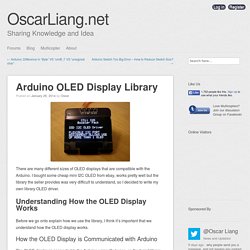
DEMO: 96×16 OLED display. It has been a while since a demonstration was posted.
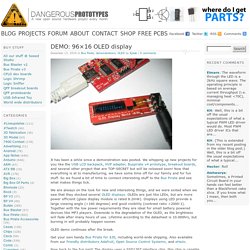
We whipping up new projects for you like the USB LCD backpack, HVP adapter, Buspirate v4 prototype, breakout boards, and several other project that are TOP-SECRET but will be released soon! Now that everything is at to manufacturing, we have some time off for our family and for fun stuff. So we found a bit of time to connect interesting stuff to the Bus Pirate and see what makes things tick. We are always on the look for new and interesting things, and we were exited when we saw that they stocked several OLED displays. 0.96" I2C IIC SPI Serial 128X64 OLED Display Module for: Amazon.co.uk: Electronics. Roll over image to zoom in Color: UG-2864HMBE G01 Blue/Yellow Color VCC : 5V power input RS/DC : Command/Data Selection RESE : LCD controller reset, active low Frequently Bought Together Customers Who Bought This Item Also Bought Special Offers and Product Promotions.
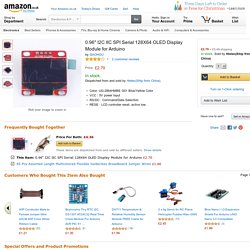
Gallery - u8glib - Gallery - Universal Graphics Library for 8 Bit Embedded Systems. Today I received a blue and a white 128x64 OLED from HalTec.
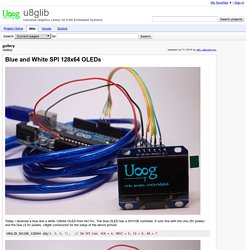
The blue OLED has a SH1106 controller. It runs fine with the Uno (5V power) and the Due (3.3V power). U8glib constructor for the setup of the above picture: 0.96" OLED i2c Display (3.3V - 5.0V) from miker on Tindie. We recognize our top users by making them a Tindarian.
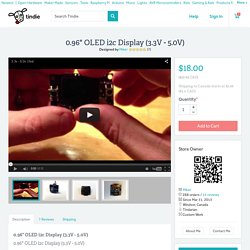
Tindarians have access to secret & unreleased features. Their product listings are automatically approved, and do not have to wait for our approval process. How does one become a Tindarian? We look for the most active & best members of the Tindie community, and invite them to join. There isn't a selection process or form to fill out. UG-2864HSWEG01%20user%20guide. Monochrome OLED Breakouts. For all of the different kinds of small OLED monochrome displays, you'll need to install the Arduino libraries.
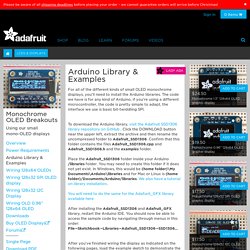
The code we have is for any kind of Arduino, if you're using a different microcontroller, the code is pretty simple to adapt, the interface we use is basic bit-twiddling SPI. To download the Arduino library, visit the Adafruit SSD1306 library repository on GitHub . Click the DOWNLOAD button near the upper left, extract the archive and then rename the uncompressed folder to Adafruit_SSD1306. Confirm that this folder contains the files Adafruit_SSD1306.cpp and Adafruit_SSD1306.h and the examples folder. Place the Adafruit_SSD1306 folder inside your Arduino /libraries folder. Robots/sunspot_programme/Bitbanging_send at master · joristork/robots. Google Translate. Google Translate. [Sun SPOT Demo(6)] OLED Display (μOLED-96-G1) を使ってみる。 (Shuichi Machida's Weblog)
Avr - u8glib - About the u8glib AVR distribution - Universal Graphics Library for 8 Bit Embedded Systems. Help getting started with a I2C OLED. I ordered a few of these OLEDs off ebay: In the picture they have 4 pins , but the ones I received have 6 (GND, VCC, D0, D1, RST, DC) I'm having a hard time getting this display to work. the listing has a link to the u8glib github for arduino source code and hook up guide, but it doesn't mention I2C displays at all.

I downloaded the library and uploaded the Hello World example using U8GLIB_SSD1306_128X64 u8g(U8G_I2C_OPT_NONE); The screen stayed black and so since I know adafruit's OLEDs use a reset pin, I tried their library but still no luck. after poking around the forum I found this: I tried using Oliver's modified library that gets around the no acknowledgement but still I appear to be SOL. I'm sure I have VCC, GND, D0 and D1 hooked up correctly, based on the datasheet D0 is the SCLK and D1 is SDA. I did also try using the I2C sniffer code, to see if I could find out what the address is, but because there's no acknowledge, the code doesn't detect the display. Forum.hobbycomponents.com - View topic - SSD1306 128x64 Pixel OLED display module (HCMODU0050&2)
Serial Peripheral Interface (SPI) Favorited Favorite 36 Introduction Serial Peripheral Interface (SPI) is an interface bus commonly used to send data between microcontrollers and small peripherals such as shift registers, sensors, and SD cards.
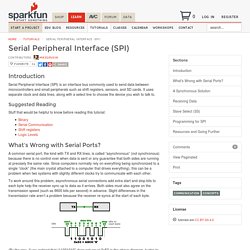
It uses separate clock and data lines, along with a select line to choose the device you wish to talk to. Suggested Reading Stuff that would be helpful to know before reading this tutorial: What's Wrong with Serial Ports? A common serial port, the kind with TX and RX lines, is called “asynchronous” (not synchronous) because there is no control over when data is sent or any guarantee that both sides are running at precisely the same rate. To work around this problem, asynchronous serial connections add extra start and stop bits to each byte help the receiver sync up to data as it arrives.
Serial Peripheral Interface Bus. SPI bus: single master and single slave Interface[edit] The MOSI/MISO convention requires that, on devices using the alternate names, SDI on the master be connected to SDO on the slave, and vice versa.

Chip select polarity is rarely active high, although some notations (such as SS or CS instead of nSS or nCS) suggest otherwise. Slave select is used instead of an addressing concept. SPI. This library allows you to communicate with SPI devices, with the Arduino as the master device. A Brief Introduction to the Serial Peripheral Interface (SPI)